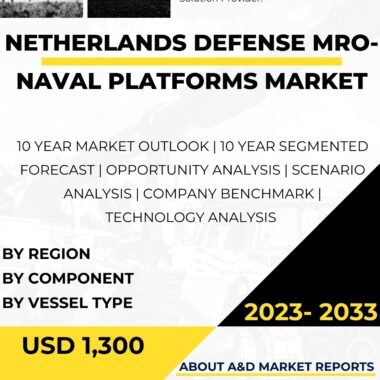Description
Maintenance, Repair, and Overhaul (MRO) of naval platforms are vital components of Canada’s defense industry, ensuring the operational readiness and reliability of military vessels. Naval platforms encompass a diverse range of maritime assets, including surface combatants, submarines, patrol vessels, and support ships used by the Royal Canadian Navy (RCN) and the Canadian Coast Guard (CCG). The MRO process for naval platforms is critical for maintaining their combat capabilities, extending their service life, and ensuring their effectiveness in safeguarding Canada’s territorial waters and supporting various defense missions.
Naval MRO in Canada is a collaborative effort that involves a combination of military personnel, civilian contractors, and naval shipyards. The synergy of expertise and resources from both military and civilian sectors enhances the efficiency and effectiveness of MRO operations, enabling the maintenance of a capable and sustainable naval fleet.
One of the fundamental aspects of naval platform MRO is the regular inspection and preventive maintenance. Periodic inspections are conducted to assess the condition of critical systems, including propulsion systems, hulls, electrical systems, and weapons. These inspections help identify potential issues and address them before they become major problems, thereby reducing the risk of equipment failure during operational deployments.
Routine maintenance tasks for naval platforms include checks and replacements of fluid levels, lubrication of mechanical components, and inspections of electrical and electronic systems. Furthermore, various components that experience wear and tear, such as propellers, valves, and pumps, are repaired or replaced to ensure optimal performance. The MRO process strictly adheres to manufacturer guidelines and maintenance manuals to maintain the highest standards of safety and reliability.
The MRO of naval platforms also encompasses more extensive repairs and refurbishments. If any components or systems are found to be faulty or damaged during inspections, they are repaired or replaced. Highly skilled naval engineers and technicians conduct repairs, adhering to strict quality control procedures to ensure that the components are restored to their original specifications.
Moreover, naval platforms undergo periodic overhauls and upgrades to modernize their capabilities and extend their service life. Overhauls involve extensive inspections and maintenance of the entire vessel, including its propulsion systems, structural integrity, and onboard equipment. Upgrades may include the integration of advanced sensors, communication systems, weapon systems, and improved survivability features.
The Canadian defense industry collaborates closely with naval vessel manufacturers and international partners to optimize the MRO process for naval platforms. This collaboration ensures access to genuine spare parts, technical support, and specialized knowledge, contributing to the efficiency and effectiveness of naval MRO. It also fosters knowledge sharing and technology transfer, enhancing the capabilities of the Canadian defense industry.
Sustainability and environmental responsibility are significant considerations in naval MRO. MRO facilities implement eco-friendly practices, such as waste recycling and energy conservation, to minimize their environmental impact. Additionally, advancements in vessel technology and materials contribute to reducing the ecological footprint of naval platforms.
Naval MRO capabilities are essential for supporting the operational readiness and deployability of the RCN and CCG. Regular maintenance and inspections ensure that naval platforms are mission-ready and can effectively fulfill their roles in various defense operations, including territorial defense, maritime security, search and rescue missions, and international peacekeeping efforts.
Furthermore, the MRO of naval platforms contributes to the overall cost-effectiveness of the Canadian Armed Forces. By extending the service life of existing vessels and modernizing them through upgrades, the need for new acquisitions can be reduced or deferred, optimizing defense expenditure.
A robust MRO capability for naval platforms supports the Canadian defense industrial base and fosters the growth of domestic expertise in ship maintenance and repair. It provides skilled employment opportunities for naval engineers, technicians, and support personnel, contributing to the development of a highly skilled workforce within the country.
In conclusion, the MRO of naval platforms is a crucial element of Canada’s defense industry. It ensures the operational readiness, reliability, and combat effectiveness of military vessels. Through regular inspections, routine maintenance, repairs, overhauls, and upgrades, MRO facilities play a vital role in supporting the RCN and CCG in safeguarding Canada’s maritime interests and fulfilling defense missions. Collaborative partnerships with industry stakeholders and a focus on sustainability further enhance Canada’s MRO capabilities, ensuring the continued readiness and effectiveness of naval platforms in protecting national security and supporting maritime security and safety.




